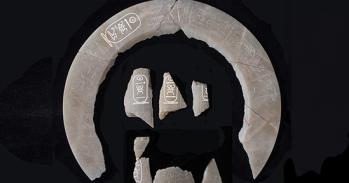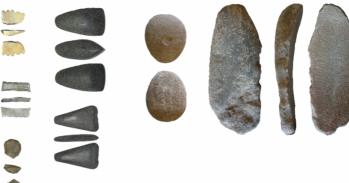
Why were Bronze Age figurines smashed, transported and buried in shallow pits on the Aegean island of Keros? New research sheds light on a 4,500-year-old mystery.
Why were Bronze Age figurines smashed, transported and buried in shallow pits on the Aegean island of Keros? New research sheds light on a 4,500-year-old mystery.
I realised that nearly all of the breakages seemed to be ancient and not the result of the looting. For some reason, all of the objects had been deliberately broken before burial.
Professor Colin Renfrew
On a June morning in 1963, Colin Renfrew stepped from a caïque boat onto the scrub-covered Aegean island of Keros on the basis of a tip-off. In search of material for his graduate studies, the young Cambridge graduate had been intrigued by rumours of a recent looting of the almost uninhabited island relayed to him by a Greek archaeologist.
Sure enough, evidence of looting abounded. As he reported back to the Greek Archaeological Service, on whose permit he had been surveying the Greek Cycladic islands, smashed marble statues and bowls and broken pottery lay scattered over the hillside.
Despite the destruction, it was clear that the fragments were Early Cycladic, an interesting find in itself. In fact, as he was to discover, he had also stumbled upon the first evidence of an astonishing Bronze Age ritual.
Broken bodies
A year later, the Greek Archaeological Service carried out a major recovery, finding fragments of a type of sculpture found previously mainly in Cycladic Bronze Age graves. The simplicity of these eerily beautiful figurines, with their folded arms, sloping feet and featureless faces, are said to have inspired Pablo Picasso and Henry Moore.
On Keros, however, apart from a single intact figurine, all others were broken. There were ‘body parts’ in their hundreds – an elongated foot, a single breast, a folded arm, a pair of thighs, a face – all jumbled together with broken bowls and pots.
When the ‘Keros Hoard’, a collection widely believed to be part of the looted material, appeared on the antiquities market in the 1970s and all the fragments were also broken, the mystery deepened. Was the site on Keros an ancient burial ground that, perhaps in haste, had been destroyed by looters, or was the site something else entirely?
A special deposit
A new opportunity to investigate came in 1987, when Renfrew, by then a Professor in the Department of Archaeology, and two Greek archaeologists were permitted to excavate and survey the looted area, which they called Special Deposit North. “We recovered great quantities of broken material and yet as we excavated more we found no indications of tombs,” said Professor Renfrew.
Not only were the fragments not grave goods but the first of several astonishing features came to light, as Professor Renfrew explained: “As I studied the marble materials for publication, I realised that nearly all of the breakages seemed to be ancient and not the result of the looting. They had been deliberately broken before burial.”
“Although this excavation didn’t resolve the puzzle, it did emphasise how rich the site was and how puzzling.” The archaeologists felt sure that more light would be shed by the investigation both of an area a few hundred metres further south that also seemed to be a Special Deposit and of the tiny steep-sided islet of Dhaskalio that lay 80 metres offshore from Keros.
Return to Keros
It was another two decades before Professor Renfrew was able to return, this time for three seasons of excavation, ending in 2008, and with an international team of almost 30 experts. The post-excavation analyses of the finds are now nearing conclusion.
In the first year, the Cambridge–Keros project team excavated at the southern site and confirmed the presence of another Special Deposit, but this time undisturbed by looters. Many of the materials were bundled together in small pits up to two metres in diameter. The breakages were old and deliberate. Moreover, the absence of marble chips, expected in the case of breakages on the spot, showed the fragments had been broken elsewhere. As later radiocarbon dating confirmed, they had been deposited over a 500-year period from 2800 BC to 2300 BC.
“But the strangest finding of all was that hardly any of the fragments of the 500-odd figurines and 2,500 marble vessels joined together,” said Professor Renfrew. “This was a very interesting discovery. The only conclusion we could come to was that these special materials were broken on other islands and single pieces of each figurine, bowl or pot were brought by generations of Cycladic islanders to Keros.”
Bronze Age guesthouse?
Meanwhile, across the short stretch of water to Dhaskalio, a very different picture was emerging. From the outset, the islet showed evidence of having been a major Bronze Age stronghold with structures built on carefully prepared terraces circling a summit, on which a large hall was erected. The settlement dates from around the time of the Special Deposits, and then continued to operate before being abandoned around 2200 BC.
Examination of its geology showed that the beautifully regular walling of the settlement was imported marble rather than the flaky local limestone found on Keros. Remarkably, in the same era that the pyramids were being built and Stonehenge was being erected, Cycladic islanders were shipping large quantities of building materials, probably by raft, over considerable distances to build Dhaskalio.
Here, too, there were puzzling finds: a stash of about 500 egg-shaped pebbles at the summit and stone discs found everywhere across the settlement. And, although there was evidence that the olive and vine were well known to the inhabitants of Dhaskalio, the terrain there and on Keros could never have supported the large population the scale of the site implies, suggesting that food also was imported.
One answer is to hypothesise a largely transient population. Several strands make this plausible, as Dr Michael Boyd, who is collating the results of the post-excavation analyses, explained: “Archaeobotanical evidence implies that the site was not intensively occupied year-round, and the imported pottery and materials suggest the possibility of groups coming seasonally from elsewhere.”
“A possible attractor to the site,” he added, “would of course be the Special Deposit on the immediately opposite shore.” In fact, team geologists believe that Dhaskalio and Keros were probably one land mass during the Early Bronze Age and that tectonic movement and rising sea levels created the divide.
Sanctuary
As the team members conclude their analyses of the finds, all indications point towards Keros having been a major ritual centre of the Cycladic civilisation. “We believe that the breaking of the statues and other goods was a ritual and that Keros was chosen as a sanctuary to preserve the effects,” said Professor Renfrew.
He speculates that the objects were used repeatedly in rituals in the home islands, perhaps carried in ritual processions in much the same way that icons are paraded today in Greek villages: “They had a use-life, probably being painted and repainted from year to year. Perhaps the convention was that when a figure had reached the end of its use-life, it could not simply be thrown away or used conventionally, it needed to be desanctified in an elaborate process.”
“Strangely,” he added, “there seems to have been some obligation to bring a piece of the broken figure and deposit it on what must have been the sacred island of Keros, possibly staying a few days on Dhaskalio while the ceremony was completed.” The missing pieces of the statues, bowls and pottery have never been located on other islands, and Professor Renfrew wonders if they were thrown into the sea during transit and have long since disintegrated.
This wouldn’t be the first time a sanctuary has been identified in the Greek islands - Delphi, Olympia and Delos, for instance – but it would be the earliest by about 2,000 years and certainly the most mysterious.
The Cambridge–Keros project was authorised by the Greek Archaeological Service and supported by the British School at Athens, with funding from the Institute for Aegean Prehistory, McDonald Institute for Archaeological Research, Society of Antiquaries of London, Stavros Niarchos Foundation, British Academy, Leventis Foundation and Leverhulme Trust. For more information, please visit
https://www.arch.cam.ac.uk/research/projects/current-projects/keros-project
This work is licensed under a Creative Commons Licence. If you use this content on your site please link back to this page.





